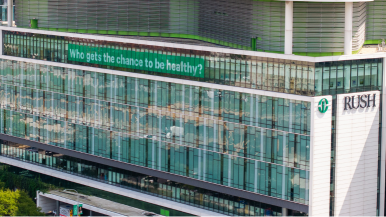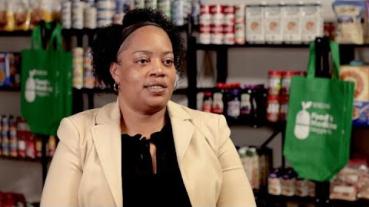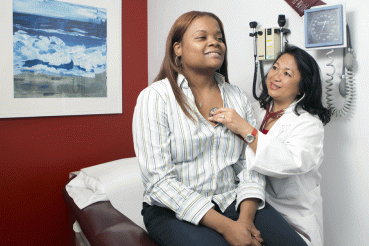Everyone deserves the chance to live their healthiest life — no matter who they are, where they live or work. That belief is core to what we do at Rush University System for Health.
We’re highlighting this issue by updating a prominent location — the windows of the Joan and Paul Rubschlager Tower on our downtown campus that face the Eisenhower Expressway — with the question: Who gets the chance to be healthy?
We are striving to spark a conversation about meaningful avenues of investment into our communities to shrink the health equity gap and protect those most at risk.
Inequities in life expectancy — people even within the same city dying years earlier from the same diseases — are not primarily driven by behavior or biology, but by social conditions like jobs, education, housing, environmental issues and segregation in the places where people live. Your neighborhood can be more important to your health than your behavior or genetics.
In Chicago’s Loop, the average life expectancy is as high as 84 years, but a baby born in East Garfield Park on the West Side has a life expectancy of only 66 years. Poverty, chronic stress and current and historical disparities in access to food, neighborhood safety and educational achievement all contribute to this inequity.
Innovative solutions for complex problems
Rush is committed to leading the way to equitable health through strategic community-centered initiatives.
“Medical care alone cannot address everything that makes people sick,” said John Rich, MD, Harrison I. Steans director of the RUSH BMO Institute for Health Equity. “We’re changing the way we think, partner and approach health.”
Recognizing that the social determinants of health — defined as non-medical factors like employment and where someone lives — can explain much of a person’s health status, Rush aims to address the root causes of disease, not just the symptoms.
At its core, health equity means that everyone has a fair chance to be as healthy as possible. Asking whether someone gets the chance to be healthy and identifying the root causes of disease help us better understand the term “health equity.” With this newfound understanding we can begin removing the obstacles to good health for all.
Transforming challenges into opportunities
Many of these obstacles people face are not found inside hospitals, clinics or doctors' offices. Fueled by this unique challenge, Rush is committed to developing new approaches to accessible, holistic, community-driven health. By applying the same dedication to quality and safety measures to equity efforts, Rush is working towards a future that has better outcomes for all our communities.
“Health is for everyone,” said David Ansell, MD, MPH, senior vice president for community health equity for Rush University Medical Center. “When we want to improve something at Rush, we measure it and then focus on how to make it better.”
In the last few years at Rush University Medical Center on Chicago’s near West Side, we’ve partnered with organizations to build a new supply chain warehouse and a multi-hospital laundry service in West Side neighborhoods. The goal is for these investments to lead to happier, longer and healthier lives for the communities we serve.
Rush has partnered with Community Development Financial Institutions to loan money to small businesses and non-profits that build affordable housing and make healthy food more available. The loans are repaid at a few percentage points lower than prime, but with a dividend of improved community health.
Just the start
This is just the beginning. Rush wants to strengthen local economies so that hundreds more people with health insurance, better housing and the ability to afford better food and medicine will translate to lower rates of preventable and life-robbing conditions like diabetes and heart disease.
The RUSH BMO Institute for Health Equity links the many health equity initiatives that the health system has spearheaded for decades. The Institute continues to serve as a catalyst for community health and vitality by finding new ways to break down barriers to health and promoting health equity both within and outside of Rush. By addressing the root causes, more people get the chance to be healthier.
We hope that more people, organizations and policymakers reflect on how they can contribute to addressing the question, “Who gets the chance to be healthy?”




